PONTIAC GRAND-AM 1993 Owners Manual
Manufacturer: PONTIAC, Model Year: 1993, Model line: GRAND-AM, Model: PONTIAC GRAND-AM 1993Pages: 306, PDF Size: 15.39 MB
Page 201 of 306
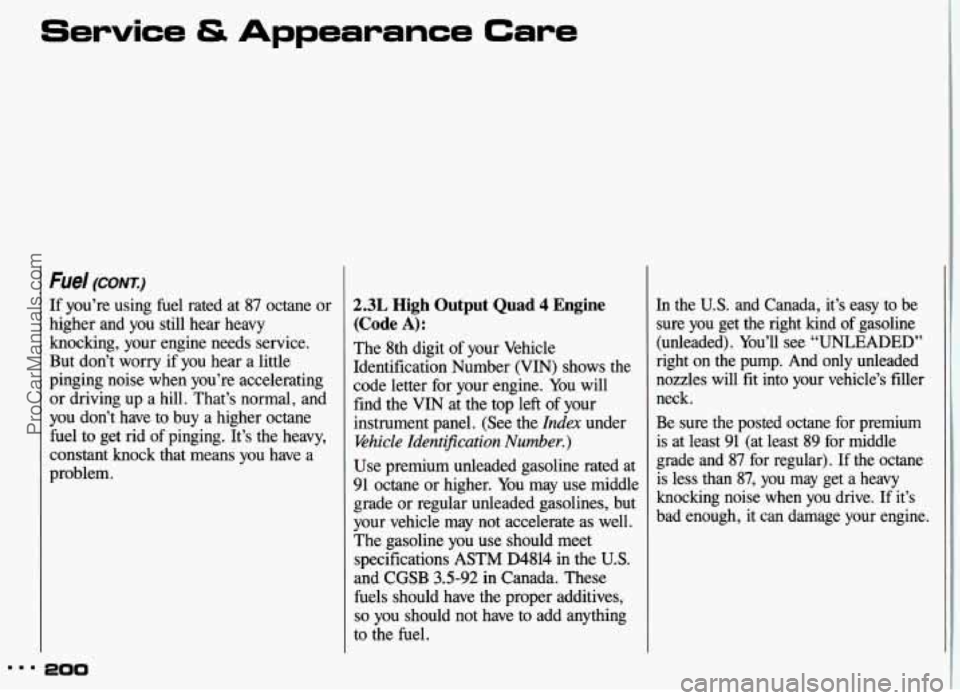
Service & Appearance Care
Fuel (CONT.:)
If you’re using fuel rated at 87 octane or
higher and you still hear heavy
knocking, your engine needs service.
But don’t
worry if you hear a little
pinging noise when you’re accelerating or driving up a hill. That’s normal, and
you don’t have to buy a higher octane
fuel to get rid of pinging. It’s the heavy,
constant knock that means you have a
txoblem.
2.3L High Output Quad 4 Engine
(Code
A):
The 8th digit of your Vehicle
Identification Number
(VIN) shows the
code letter for your engine. You will
find the VIN at the top left of your
instrument panel. (See the
Index under
Rhicle ldentijication Number.)
Use premium unleaded gasoline rated at
91 octane or higher. You may use middle
grade or regular unleaded gasolines, but
your vehicle may not accelerate as well.
The gasoline
you use should meet
specifications
ASTM D4814 in the U.S.
and CGSB 3.5-92 in Canada. These
fuels should have the proper additives,
so you should not have to add anything
to the fuel.
In the U.S. and Canada, it’s easy to be
sure
you get the right kind of gasoline
(unleaded).
You’ll see “UNLEADED”
right on the pump. And only unleaded
nozzles will
fit into your vehicle’s filler
neck.
Be sure the posted octane for premium
is at least 91 (at least 89 for middle
grade and
87 for regular). If the octane
is less than
87, you may get a heavy
knocking noise when you drive.
If it’s
bad enough, it can damage your engine.
888 a00
ProCarManuals.com
Page 202 of 306
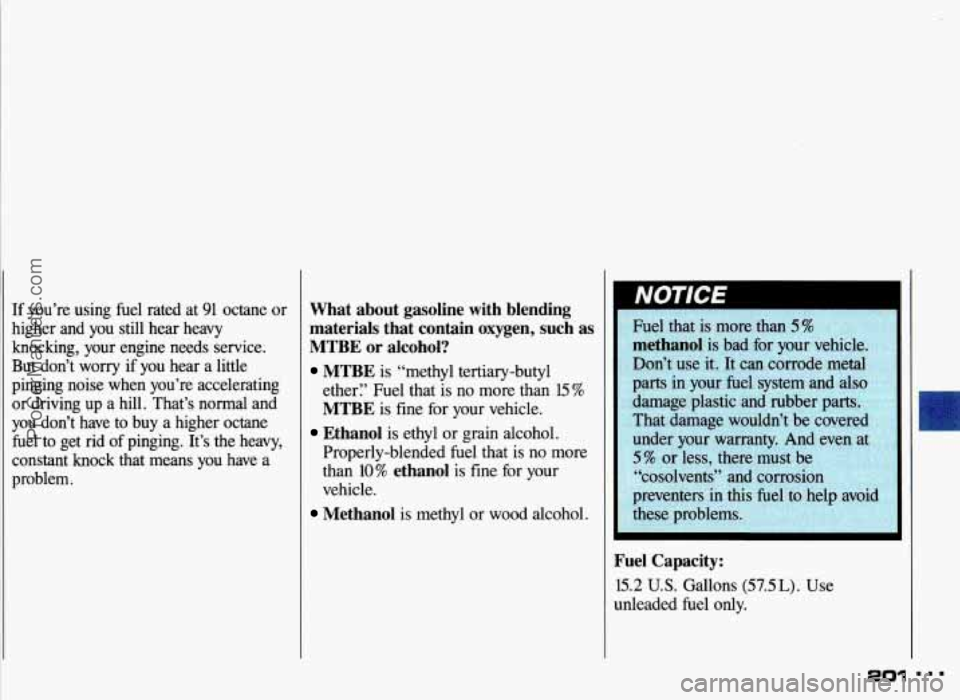
If you’re using fuel rated at 91 octane or
higher and you still hear heavy
knocking, your engine needs service.
But don’t worry
if you hear a little
pinging noise when you’re accelerating
or driving up a hill. That’s normal and
you don’t have to buy a higher octane
fuel to get rid
of pinging. It’s the heavy,
constant knock that means you have a
problem.
What about gasoline with blending
materials that contain oxygen, such as
MTBE
or alcohol?
MTBE is “methyl tertiary-butyl
ether? Fuel that is no more than
15 %
MTBE is fine for your vehicle.
Ethanol is ethyl or grain alcohol.
Properly-blended fuel that is no more
than
10% ethanol is fine for your
vehicle.
Methanol is methyl or wood alcohol.
I
Fuel that is more than 5 %
methanol is bad for your vehicle.
Don’t use it. It can corrode metal
parts in your fuel system and also
damage plastic and rubber parts. That damage wouldn’t be covered
under your warranty. And even at
5 % or less, there must be
: .. .‘‘cosolvents” and corrosion
’ ’preventers in this fuel to help avoid
these problems.
Fuel Capacity:
15.2 U.S. Gallons (57.5L). Use
unleaded fuel only.
eo1
ProCarManuals.com
Page 203 of 306
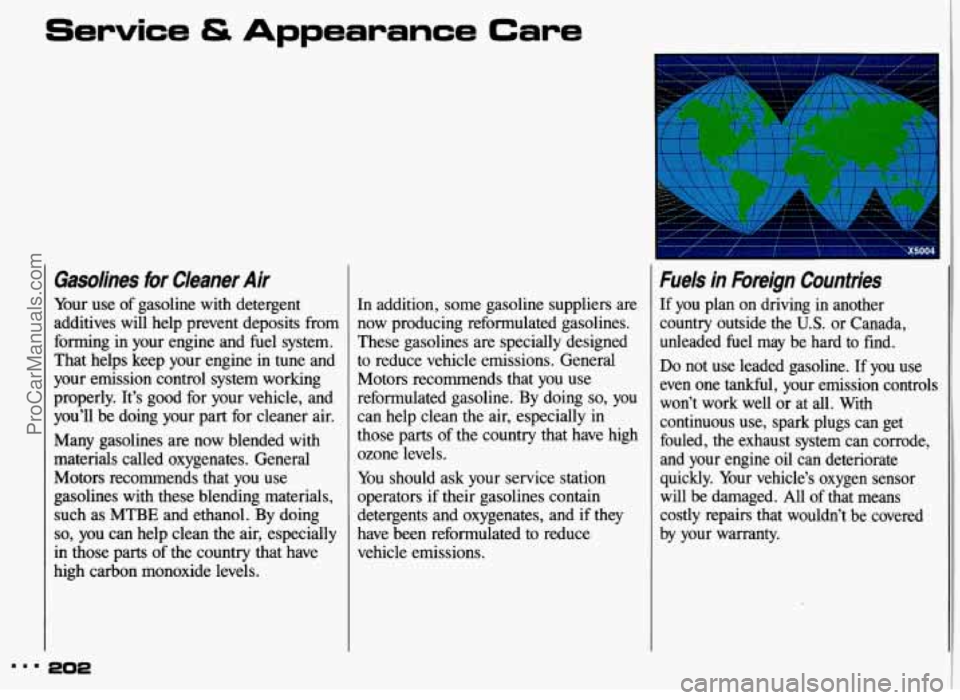
3
Gasolines for Cleaner Air
Your use of gasoline with detergent
additives will help prevent deposits from
forming in your engine and fuel system.
That helps keep your engine in tune and
your emission control system working
properly. It’s good for your vehicle, and
you’ll be doing your part for cleaner air.
Many gasolines are now blended with
materials called oxygenates. General
Motors recommends that you use
gasolines with these blending materials,
such as MTBE and ethanol. By doing
so, you can help clean the air, especially
in those parts of the country that have
high carbon monoxide levels. In
addition, some gasoline suppliers are
now producing reformulated gasolines.
These gasolines are specially designed
to reduce vehicle emissions. General
Motors recommends that you use
reformulated gasoline. By doing
so, you
can help clean the air, especially in
those parts of the country that have high
ozone levels.
You should ask your service station
operators if their gasolines contain
detergents and oxygenates, and if they
have been reformulated to reduce
vehicle emissions.
Fuels in Foreign Countries
If you plan on driving in another
country outside
the U.S. or Canada,
unleaded fuel may be hard to find.
Do not use leaded gasoline. If you use
even one tankful, your emission controls
won’t work well or at all. With
continuous use, spark plugs can get
fouled, the exhaust system can corrode,
and your engine oil can deteriorate
quickly. Your vehicle’s oxygen sensor
will be damaged. All of that means
costly repairs that wouldn’t be covered
by your warranty.
ProCarManuals.com
Page 204 of 306
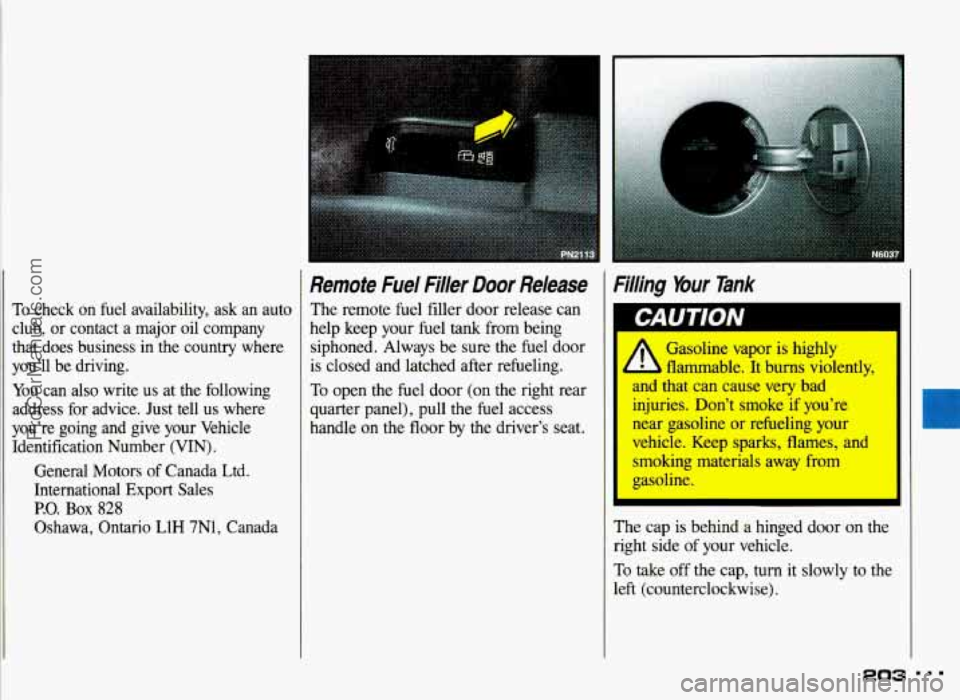
To check on fuel availability, ask an auto
club, or contact a major oil company
that does business in the country where
you’ll be driving.
You can also write us at the following
address for advice. Just tell us where
you’re going and give your Vehicle Identification Number (VIN)
.
General Motors of Canada Ltd.
International Export Sales
P.O. Box 828
Oshawa, Ontario L1H 7N1, Canada
Remote Fuel Filler Door Release
The remote fuel filler door release can
help keep your
fuel tank from being
siphoned. Always be sure the fuel door
is closed and latched after refueling.
To open the fuel door (on the right rear
quarter panel), pull the fuel access
handle on the floor by the driver’s seat.
Wing Your Tank
A Gasoline vapor is highly
and that can cause very bad
injuries. Don’t smoke
if you’re
near gasoline or refueling your
vehicle. Keep sparks, flames, and
smoking materials away from
gasoline.
L flammable. It burns violently,
I
‘he cap is behind a hinged door on the
ight side
of your vehicle.
o take off the cap, turn it slowly to the
:ft (counterclockwise).
203
ProCarManuals.com
Page 205 of 306
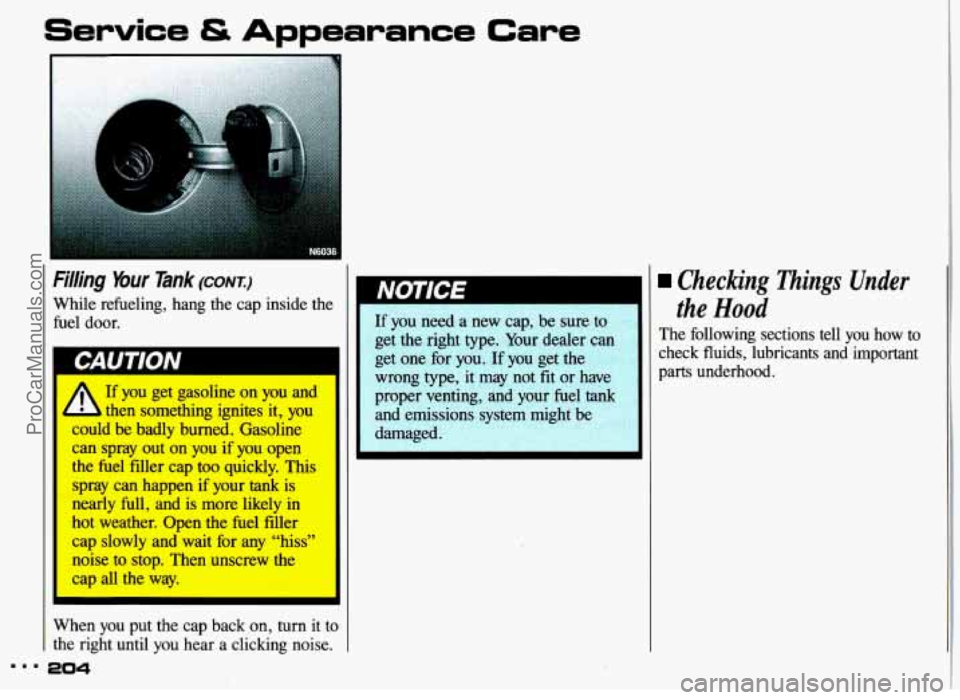
Service & Appearance Care
Filling Your Tank CON^)
While refueling, hang the cap inside the
fuel door.
A If you get gasoline on you and
- then something ignites it, you
could be badly burned. Gasoline
can spray out on you if you open
the fuel filler cap too quickly, This I
spray can happen if your tank is
nearly full, and is more likely in I
hot weather. Open the he1 filler
cap slowly and wait for any “hiss”
noise to stop. Then unscrew the
cap all the way.
When you put the cap back on, turn it to
the right until you hear a clicking noise.
204 ...
I’y ‘I ICIC
If you need a new cap, be sure to
get
the right type. Your dealer can , ,
get one for you. If you get the
wrong type, it may not fit or have
proper venting, and your fuel
tank
and emissions system might be
damaged. I
Checking Things Under
the Hood
The following sections tell you how to
check fluids, lubricants and important
parts underhood.
ProCarManuals.com
Page 206 of 306

N61b ~
Hood Release
To open the hood, first pull the HOOD
release handle inside the vehicle.
I
1
Then go to the front of the vehicle and
release the secondary hood release. Lift the hood, release the hood prop rod
from its retainer and put the hood prop into the slot in the
hood.
205
ProCarManuals.com
Page 207 of 306
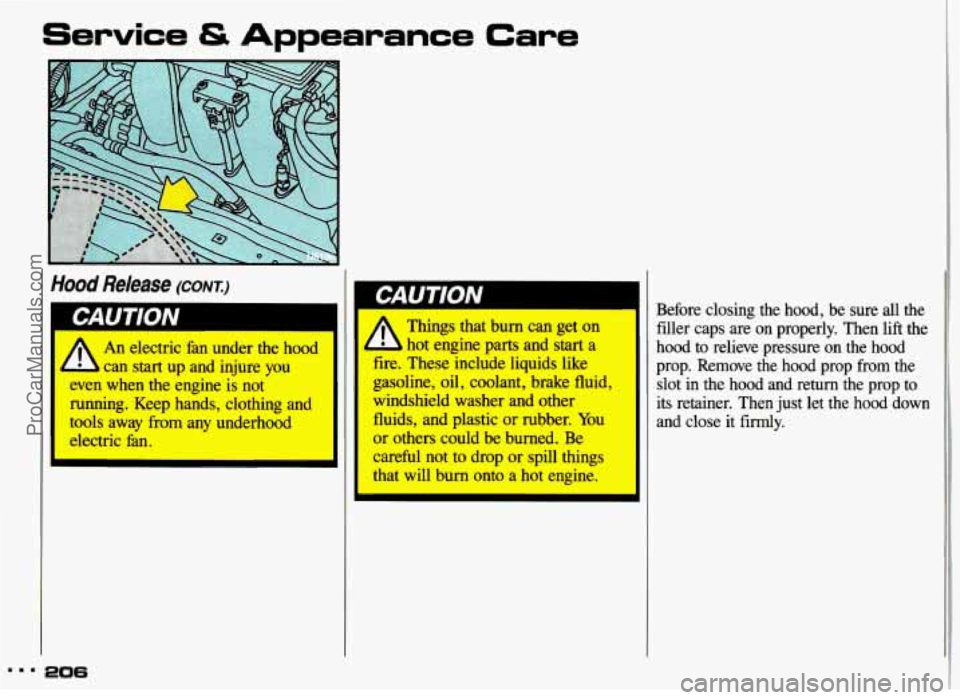
Service & Appearance Care
Hood Release (CONT.)
~1 CAUTION
An electric fan under the hood 1
IhlUlll 0
A
Things that burn can get
hot engine parts and start a
can start up and injure you fire. These include liquids like
even when the engine is not gasoline, oil, coolant, brake fluid,
running. Keep hands, clothing and windshield washer and other
tools away from any underhood fluids, and plastic or rubber. You
or others could be burned. Be
careful not to drop or spill things
that will burn onto a Rot engine,
I’
Before closing the hood, be sure all the
filler caps are on properly. Then lift the
hood to relieve pressure on the hood
prop. Remove the hood prop from the slot in the hood and return the prop to
its retainer. Then just let the hood down
and close
it firmly.
... 206
ProCarManuals.com
Page 208 of 306
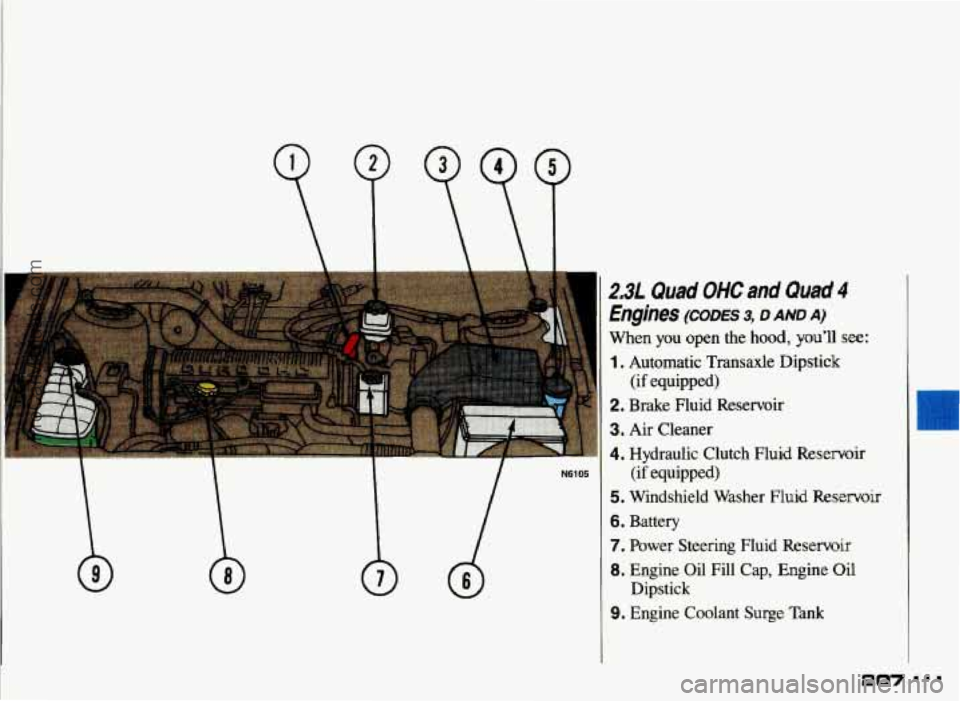
2.3L Quad OHC and Quad 4
Engines (CODES 3, D AND A)
When you open the hood, you'll see:
1 . Automatic Transaxle Dipstick
2. Brake Fluid Reservoir
3. Air Cleaner
4. Hydraulic Clutch Fluid Reservoir
5. Windshield Washer Fluid Reservoir
6. Battery
7. Power Steering Fluid Reservoir
8. Engine Oil Fill Cap, Engine Oil
9. Engine Coolant Surge Tank
(if equipped)
(if equipped)
Dipstick
ProCarManuals.com
Page 209 of 306
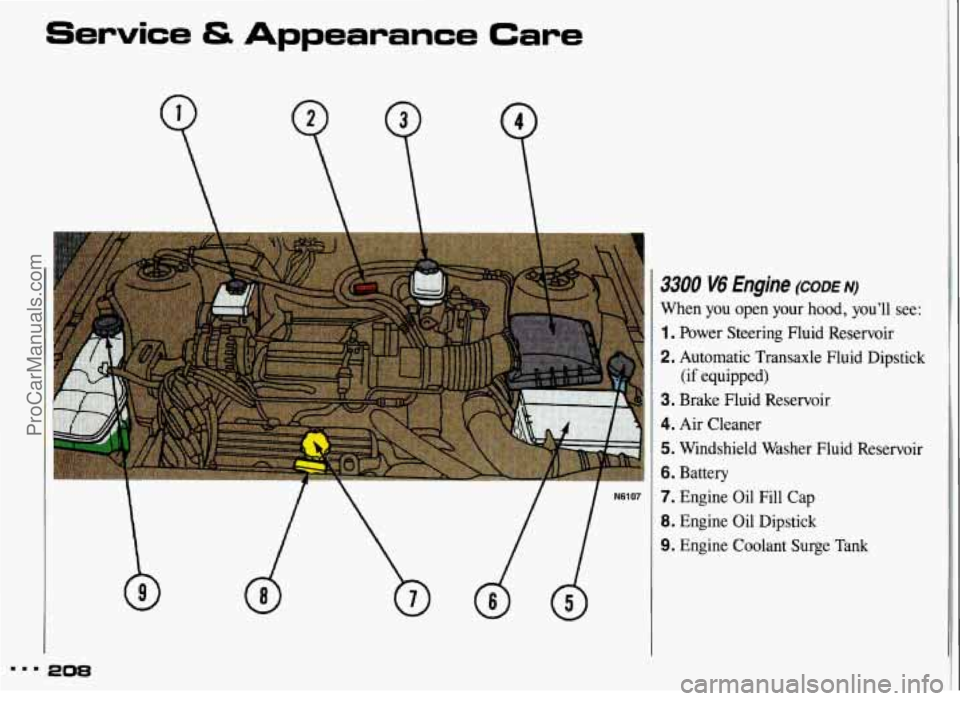
Service & Appearance Care
208
3300 V6 Engine (CODE N)
When you open your hood, you’ll see:
1. Power Steering Fluid Reservoir
2. Automatic Transaxle Fluid Dipstick
3. Brake Fluid Reservoir
4. Air Cleaner
5. Windshield Washer Fluid Reservoir
6. Battery
7. Engine Oil Fill Cap
8. Engine Oil Dipstick
9. Engine Coolant Surge Tank
(if equipped)
ProCarManuals.com
Page 210 of 306
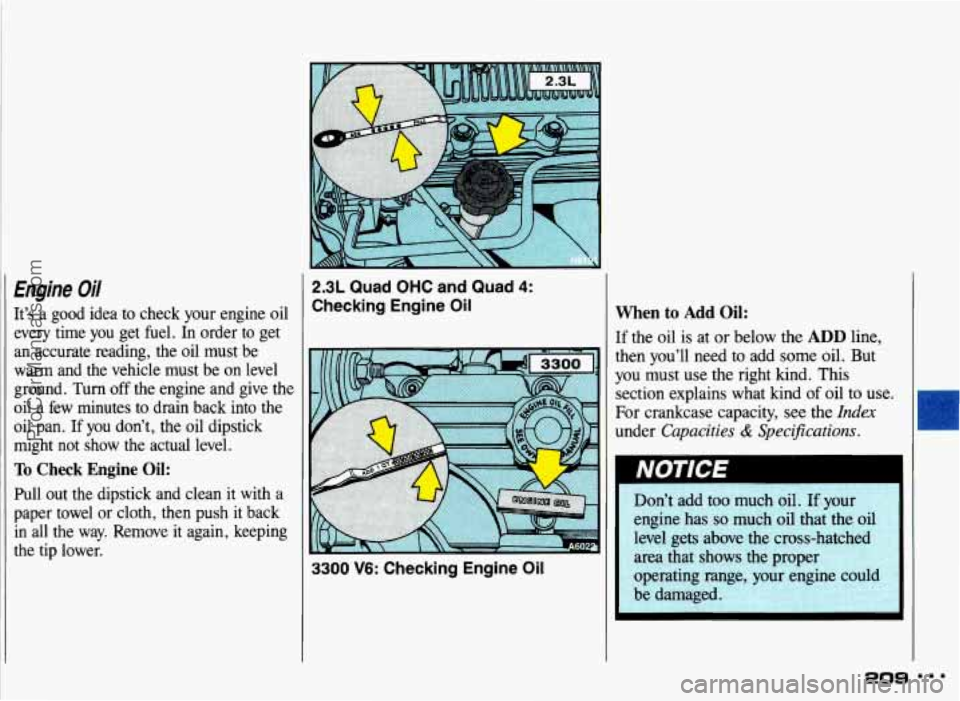
Engine Oil
It’s a good idea to check your engine oil
every time you get fuel. In order to get
an accurate reading, the
oil must be
warm and the vehicle must be
on level
ground. Turn
off the engine and give the
oil a few minutes to drain back into the
oil pan. If you don’t, the oil dipstick
might not show the actual level.
To Check Engine Oil:
Pull out the dipstick and clean it with a
paper towel or cloth, then push
it back
in all the way. Remove it again, keeping
the tip lower.
2.3L Quad OHC and Quad 4:
Checking Engine Oil
3300 V6: Checking Engine Oil
When to Add Oil:
If the oil is at or below the ADD line,
then
you’ll need to add some oil. But
you must use the right kind. This
section explains what kind
of oil to use.
For crankcase capacity, see the Index
under Capacities & Spec$kations.
20s
ProCarManuals.com